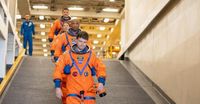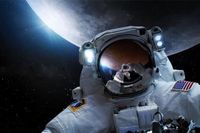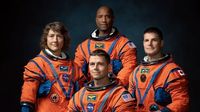More than half a century after Neil Armstrong’s iconic words echoed across the globe—“one small step for a man, one giant leap for mankind”—NASA is preparing to write a new chapter in human space exploration. The Artemis II mission, scheduled for launch as soon as February 2026, will send four astronauts on a ten-day journey around the Moon, marking the first time humans venture beyond low Earth orbit since Apollo 17 in 1972. The mission’s significance is not just in its technical ambition, but also in its spirit of international cooperation, scientific discovery, and the rekindling of public imagination.
At the heart of Artemis II is the newly christened Orion spacecraft, now officially named Integrity. The name, announced during a press conference on September 18, 2025, reflects the collective effort of thousands of engineers, scientists, and technicians who have poured their expertise and passion into the Artemis program. Commander Reid Wiseman explained the choice, saying, “We just sat with every name we had ever thought, and funny enough, ‘Integrity’ wasn’t on that list when we all sat down. I think Christina threw that name in kind of toward the end. Once ‘Integrity’ was thrown out there, it was minutes, and we were done.”
The crew—Commander Reid Wiseman, Pilot Victor Glover, Mission Specialist Christina Koch, and Canadian Space Agency astronaut Jeremy Hansen—embodies both experience and diversity. Koch, renowned for her record-breaking stint aboard the International Space Station, brings a wealth of operational know-how. Glover, a California native and distinguished Navy aviator, previously flew as part of Expedition 64 on the ISS. Hansen, the first Canadian to journey beyond low Earth orbit, represents the growing international dimension of lunar exploration.
For the Artemis II astronauts, the mission is more than a technical test—it’s a proving ground for the future of lunar and deep space exploration. Their 10-day odyssey will see them travel at least 5,000 nautical miles (9,200 kilometers) past the Moon, farther than any previous crewed mission. As Jeff Radigan, the lead Artemis II flight director, told reporters, “They’re going at least 5,000 nautical miles past the Moon, which is much higher than previous missions have gone.” The trajectory is designed to maximize both systems testing and scientific opportunity, offering a rare chance for the crew to observe up to 60 percent of the Moon’s far side—regions never directly seen by human eyes.
The mission’s main goal is to validate the life support and communication systems that will be critical for future landings. As Lakiesha Hawkins, NASA’s acting deputy associate administrator, emphasized at a recent news conference, “We together have a front row seat to history. The launch window could open as early as the fifth of February, but we want to emphasize that safety is our top priority.” The Artemis II crew will remain inside Orion for the entire mission, which offers about as much room as two minivans—a tight squeeze for four people over 10 days. Koch acknowledged the challenge, noting, “We are just ready to take those little inconveniences, but also the communication that it takes to know when someone does need a little alone time.”
Preparation for such close quarters has been intense. The astronauts have spent over two years training side by side, engaging in long-duration simulations that mimic the fatigue, stress, and lack of privacy they’ll encounter in space. They’ve practiced responding to simulated equipment failures, with instructors deliberately introducing breakdown scenarios to sharpen the crew’s problem-solving skills. As Hansen observed, the central lesson is learning “how to respond effectively when the unexpected occurs.”
But Artemis II is not just about engineering. The mission will also serve as a platform for scientific discovery. During their journey, the astronauts will help monitor how their bodies respond to the rigors of deep space. NASA scientists will grow tissue samples, or organoids, from the astronauts’ blood before and after the flight to study the effects of microgravity and radiation. Dr. Nicky Fox, NASA’s head of science, explained to BBC News, “We want to be able to study in depth the effect of the microgravity and the radiation on these samples. I’m certainly not going to dissect an astronaut! But I can dissect these little organoid samples and really look at the difference.”
The Artemis II mission will also bring the public along for the ride. Orion is equipped with six windows, two of which are positioned for direct observation of the Moon. The crew will rotate shifts to capture photographs and video, offering new visual records of Earth’s satellite and a unique perspective on the lunar far side. Koch highlighted the value of human observation, remarking, “Believe it or not, human eyes are one of the best scientific instruments that we have.”
As for the journey itself, Artemis II will launch atop NASA’s powerful Space Launch System (SLS) rocket. After reaching Earth orbit, the Orion capsule will separate from the rocket’s upper stage and perform a series of maneuvers, including a Proximity Operations Demonstration—essentially a “space ballet”—to rehearse future docking procedures. A critical Translunar Injection burn will then send Orion and its crew on a four-day voyage to the Moon. After swinging past the lunar far side, the spacecraft will begin its return journey, culminating in a splashdown off the coast of California.
While the Artemis II astronauts focus on collaboration and inspiration, NASA leadership has not shied away from framing the mission as part of a new space race. Sean Duffy, NASA’s acting administrator, recently remarked, “I’ll be damned if the Chinese beat NASA. We are going to win,” referencing China’s ambitions to land astronauts on the Moon by 2030. The Artemis II crew, however, has stressed the importance of international unity. Hansen told reporters, “Collaboration needs to be the ultimate goal if eight billion of us are going to have a bright future on this planet.”
The mission’s timeline is tight but ambitious. After the uncrewed Artemis I flight in 2022—largely successful, though not without issues such as unexpected heat shield damage—NASA initially targeted a 2024 launch for Artemis II. Delays pushed the date to April 2026, but recent signs at Johnson Space Center optimistically count down to a February launch. However, even if Artemis II goes flawlessly, the subsequent Artemis III lunar landing, currently targeted for mid-2027, faces hurdles. As Lori Glaze, NASA’s acting associate administrator for human exploration, admitted, SpaceX’s Starship—the planned lunar lander—remains behind schedule.
For the Artemis II astronauts, their legacy is not about personal fame but about opening new frontiers. Wiseman summed it up with humility: “If we are forgotten, then Artemis has been successful. We have humans on Mars. We have humans out on the moons of Saturn. We are expanding in the solar system. Maybe we inspired some kids somewhere, and maybe that’s our footnote. We inspired Susie or Johnny to do what they did. That would be magical.”
As the countdown to Artemis II continues, the world watches with anticipation, eager to see what new wonders await when humanity once again ventures beyond the familiar shores of Earth.


